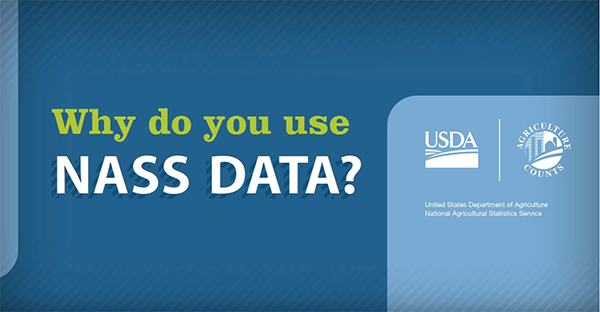- Data & Statistics
Access Quick Stats (searchable database)
The Quick Stats Database is the most comprehensive tool for accessing agricultural data published by NASS. It allows you to customize your query by commodity, location, or time period.
Access Quick Stats Lite
Quick Stats Lite provides a more structured approach to get commonly requested statistics from our online database.
Explore Statistics
County Level Information
Geospatial Data & Interactive Maps
- Publications
Browse NASS Reports
- by Subject
- by Date (Reports Calendar)
- by Title/Release Day
- by Keyword
- Guide to Products and Services
Additional Reports
Historical Publications
- Archived Ag Census Reports (2002 and prior - published every 5 years)
- Annual Agricultural Statistics
- Statistical Bulletins (final estimates, 1987 to 2012
- Track Records: (crops, livestock, grain stocks)
- Trends 20th century
- Price Reactions (after crop or livestock reports)
Receive Reports by Email:
- Newsroom
News Releases
12/16/24 USDA Releases the 2023 Census of Aquaculture Results
11/07/24 NASS releases 2022 Census of Agriculture Zip Code Tabulations
10/31/24 2023 Irrigation and Water Management data now available
10/23/24 USDA seeks nominations for the Advisory Committee on Agriculture Statistics
10/11/24 US corn production up while soybean production down from September
Read More News
ASB Notices
09/25/24 NASS to publish 2023 Irrigation and Water Management report earlier
07/31/24 NASS to Review Acreage Data
04/15/24 NASS appoints Lance Honig as new ASB Chair
04/09/24 NASS discontinues select 2024 data collection programs and reports
04/04/24 NASS announces program changes following five-year review
Read More Notices
Videos
02/13/24 2022 Census of Agriculture Data Highlights
02/13/24 How to Find 2022 Census of Agriculture Data
02/13/24 2022 Census of Agriculture Data Release Event
07/16/21 What is a Farm?
08/05/20 The NASS Mission: We do it for you
View More Videos
ASB Briefings
12/10/24 Crop Production (December 2024)
11/08/24 Crop Production (November 2024)
10/11/24 Crop Production (October 2024)
09/30/24 Small Grains Summary and Grain Stocks (September 2024)
View More Briefings
- Surveys
- Census
- About NASS
Structure and Organization
- Agency Overview
- NASS Biographies
- Organizational Chart
- Assistance to Other Organizations
- International Programs
- NASS Strategic Plan for FY 2022-2026
- USDA Strategic Goals
- NASS Climate Adaptation and Resilience Plan
Guiding Principles
- Mission and Core Values
- Keeping Data Safe
- Confidentiality Pledge
- Security Pledge
- Security Statement
- Statement of Commitment to Scientific Integrity
- Regulations Guiding NASS
- Information Quality
- Learning Agenda, Fiscal Year 2024 -2026
Civil Rights
Work at NASS
Education and Outreach
- Understanding Ag Statistics
- Data Users' Meetings
- Morris Hansen Lecture
- International Conference on Agricultural Statistics
History and Procedures
- Agricultural Statistics Board and Lockup
- Agricultural Statistics: A Historical Timeline
- The Story of U.S. Agricultural Estimates
- As We Recall: The Growth of Agricultural Estimates, 1933-1961
-
Safeguarding America's Agricultural Statistics Report and Video
- History of Ag Statistics
- Report Procedures
- An Evolving Statistical Service
- Fact Finders for Agriculture
- Hall of Fame
- Contact Us
Mailing Address:
USDA-NASS
1400 Independence Ave., SW
Washington, DC 20250Survey FAQs and Contact Us:
Access FAQs or submit a question.
Data Inquiries:
Hours: 7:30 a.m. - 4:00 p.m. Eastern Time
Monday - Friday, except federal holidays
Toll-Free: (800) 727-9540Media Inquiries:
Other USDA Inquiries:
Hours: Monday to Friday 8 a.m. - 5 p.m. EST
Toll-Free: (833) One-USDA
Email: askusda@usda.gov
Website: https://ask.usda.gov/s/Civil Rights Office:
June Turner, Director
Email: / Phone: (202) 720-8257Translation Services:
Regional and State Field Offices:
Find contact information for Regional and State Field Offices
Ask a Specialist:
Have a specific question for one of our subject experts? Contact a specialist.
Web Content Publishing Schedule:
Section 207(f)(2) of the E-Government Act of 2002 requires federal agencies to develop an inventory of information to be published on their Web sites, establish a schedule for publishing information, make those schedules available for public comment, and post the schedules and priorities on the Web site.
- Help
Technical Issues
Surveys

Agricultural Resource Management Survey (ARMS) is the U.S. Department of Agriculture’s primary source of information on the production practices, resource use, and economic well-being of America’s farms and ranches. The results of this survey are the only source of information available for objective evaluation of many critical issues related to agriculture and the rural economy.
Farmer participation in ARMS ensures that policy makers and others, including farmers and ranchers themselves, base important decisions on facts straight from the source. ARMS also tells the story of American agriculture to the public that has less and less direct contact with the farm community.
Respond Online
Click here to complete your survey online. Remember, you will need your unique survey code to sign in.
Watch these Videos on the Importance of ARMS, NASS Data, and Responding to Surveys
Publications Where ARMS Data are Used
USDA analyzes ARMS results and releases information throughout the year about farm production practices. Below are some of the reports produced by USDA using ARMS data.
- ARMS Farm Financial and Crop Production Practices (ERS)
- Farm Income and Financial Forecast (ERS)
- Farm Household Income and Characteristics (ERS)
- Farm Income and Wealth Statistics (ERS)
- Farm Production Expenditures Annual Summary (NASS)
- Uses of Arms Data (video) (ERS)
Access the data in Quick Stats database:
View and download data from the NASS Quick Stats database.
- Choose the detailed database (Quick Stats 2.0).
- In Quick Stats 2.0, under Program, select "Survey."
- Make additional category choices for the data you are looking for.
- Click to read about the Quick Stats Tools
Want to receive reports automatically? Click an option below to subscribe.
Data Visualizations:
Charts and Maps:
Methodology and Quality Measures
July 26, 2024
- Methodology and Quality Measures
- Report Form (Version 1)
- Report Form (Version 2)
- Report Form (Version 3)
- Report Form (Version 4)
July 28, 2023
July 29, 2022
- Methodology and Quality Measures
- Report Form (Version 1)
- Report Form (Version 2)
- Report Form (Version 3)
- Report Form (Version 4)
July 30, 2021
July 31, 2020
- Methodology and Quality Measures
- Report Form (Version 1)
- Report Form (Version 2)
- Report Form (Version 3)
- Report Form (Version 4)
August 2, 2019
August 2, 2018
August 3, 2017
August 5, 2016
August 4, 2015
August 1, 2014
August 2, 2013
August 2, 2012
August 2, 2011
Program Content
ARMS is the primary source of information to the U.S. Department of Agriculture and the public on a broad range of issues about U.S. agricultural resource use, costs, and farm sector financial conditions. The ARMS is the only source of information available for objective evaluation of many critical issues related to agriculture and the rural economy. The survey is conducted in collaboration with the Economic Research Service (ERS).
The sample is designed to provide coverage of all farms in the 48 contiguous States plus state level data for 15 major cash receipts states. The farm population includes all establishments which produced and sold, or would normally have sold, at least $1,000 of agricultural products during the previous year. A sample from the NASS list frame is supplemented by a sample of area tracts to ensure complete coverage.
Publications
NASS publishes two reports from ARMS. The first is called Agricultural Chemical Usage - Field Crops and is released in May following the Phase II data collection. The second report is the Farm Production Expenditures, compiled from the Phase III, is released in August. ERS prepares several state, regional, and national reports using ARMS data including Commodity Production Costs and Returns, Farm Operating and Financial Characteristics and the Annual Report to Congress on the Status of Family Farms.
Methodology
The ARMS collects production practices and cost of production data on selected commodities. The ARMS also collects detailed whole farm financial information from a representative sample of farms and ranches across the country. ARMS is collected in three data collection phases:
The initial phase, ARMS Screening survey, collects general farm data such as crops grown, livestock inventory, and value of sales. Screening data are used to qualify (or screen) farms for the other phases.
The second phase, (Phase II), collects data associated with agricultural production practices, resource use, and variable costs of production for specific commodities. Commodities are surveyed on a predetermined rotation with up to five commodities surveyed in a given year. Farm operators provide data on fertilizer and nutrient applications, pesticide applications, pest management practices, and irrigation.
The final phase, (Phase III) collects whole farm finance, operator characteristics, and farm household information. Farm operators provide data on farm operating expenditures, capital improvements, assets, and debt for agricultural production. In addition, operators provide data on farm-related income, government payments, the source and amount of off-farm income, and characteristics of themselves and their household.
Uses
Farm organizations, commodity groups, agribusiness, Congress, and the USDA use information from ARMS to evaluate the financial performance of farm/ranch businesses and to make policy decisions affecting agriculture. The Bureau of Economic Analysis (BEA) uses ARMS data to calculate the farm sector portion of the Gross Domestic Product (GDP) for the nation.
ARMS data provide the necessary background information to support evaluations of the relationships among agricultural production, resources and the environment.
Frequency
The three phase survey is conducted annually. The initial phase is conducted from May through July. Phase II is conducted from September through December. Phase III is conducted from February through April with the reference period the previous year. Respondents sampled in Phase II are asked to complete a Phase III report. Data from both phases provide the link between agricultural resource use and farm financial conditions.
Methods
Operators are selected to assure adequate coverage by state and region and to minimize reporting burden. Strata are based on state, value of agricultural sales and type of farm. Phase I screening is performed by mail and phone. Operators that are in business and/or have the commodity of interest are eligible to be selected for Phase II or Phase III. The commodity of interest is determined by the ERS. Phases II data are collected by personal interview. Phase III data are collected by mail, phone, and personal interview.
Special Features
The efficiency and strength of the ARMS design allows the survey to address policy questions relevant to resource use or financial issues. For example, commodity versions are rotated every 5-6 years to focus on resource use and production costs for specific commodities.
Related Programs
Census of Agriculture
Fruit and Vegetable Chemical Use
ARMS Outreach Toolkit
Resources for enumerators, media, and producers that help explain the survey and how ARMS data are used.
ARMS Survey Data Collection Materials
NASS collects ARMS data in three separate phases throughout the year. Below are the questionnaires used in each of the phases.
- Phase 1 (May - June)
- Phase 2 (September – December)
- 2023 ARMS 2 Barley Questionnaire
- 2023 ARMS 2 Oat Questionnaire
- 2023 ARMS 2 Peanuts Questionnaire
- 2023 ARMS 2 Soybean Questionnaire
- Phase 3 (January - April)
Last Modified: 04/18/2024















